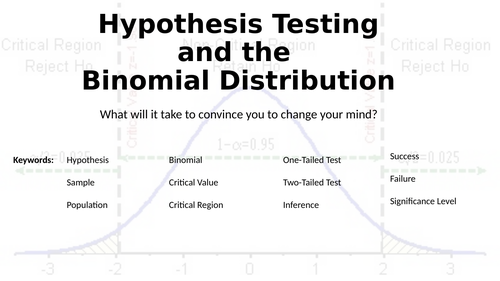






This 45 slide PowerPoint presentation takes you carefully through the contains of Chapter 7 of Edexcel’s Statistics and Mechanics Year 1/AS Book i.e. “Hypothesis Testing”.
I have uploaded a free preview of this presentation to TES so that you can see the level of detail, and presentation style, that I have used.
This chapter deals with performing Hypothesis Tests using the Binomial Distribution.
This presentation is ideal if you are using Edexcel’s recommend testbook
[ ISBN 978-1-292-23253-9 ].
However, the content is also very useful if you are using any other A Level textbook.
The presentation starts with a recap of the Binomial Distribution and how to compute probabilities from it. It shows how to directly compute probabilities from the Binomial Distribution, how to use the Cumulative Binomial Distribution tables, and how to use Casio calculators, both graphical (fx-9860, CG20 ,CG50) and scientific (fx-991EX).
It then covers one-tailed and two-tailed Hypothesis tests, both as a theoretical mathematical task, and within examination questions set within real-world contexts.
We cover both performing a Hypothesis Test directly, and calculating the Critical Values, Critical Regions and the Acceptance Region.
The Required Significance Level and the Actual Significance Level of the Hypothesis Test are clearly explained.
The two ways of performing a 2-tailed test Hypothesis Test are carefully explained i.e. strictly requiring that each critical region has a probability less than alpha/2, and making each critical region have a probability that is as close as possible to alpha/2.
Teacher notes are provided for each slide.
I have also included my solutions to all the exercises in the chapter. I have not tried to do the questions in the same way as the solution bank, so I think you will find my solutions useful.
Errors in the chapter, the book’s answers and in the solution bank are pointed out.
The presentation extensively uses “Appear on Click” so that you can step the students through the contents of each slide. No other animations are used as I think these can become an unnecessary distraction.
I hope you find the resource very useful within your teaching practice.
I am very happy to receive any feedback you might have.
Regards and best wishes
Gerard
Something went wrong, please try again later.
This resource hasn't been reviewed yet
To ensure quality for our reviews, only customers who have purchased this resource can review it
Report this resourceto let us know if it violates our terms and conditions.
Our customer service team will review your report and will be in touch.